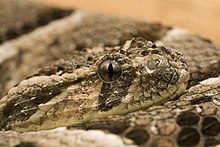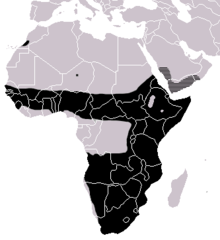Puff adder
| Puff adder | ||||||||||||
|---|---|---|---|---|---|---|---|---|---|---|---|---|

Puff adder ( Bitis arietans ) |
||||||||||||
| Systematics | ||||||||||||
|
||||||||||||
| Scientific name | ||||||||||||
| Bitis arietans | ||||||||||||
| ( Merrem , 1820) |
The puff adder ( Bitis arietans , outdated Bitis lachesis ), also common puff adder , is a venomous snake from the viper family , which occurs throughout Africa and parts of the southwestern Arabian peninsula with the exception of the inner Sahara and rainforest areas. Due to its powerful hemotoxin , its widespread distribution and frequency, it is responsible for most of the dangerous venomous snake bites in Africa.
It is named after the typical threatening gestures and noises that the animals produce when threatened. The snakes puff up and release the air in loud hissing and popping noises ("puffs").
features
The puff adder has a very compact, strong body with a broad, short and flat head, clearly set off from the neck. Their coloration is variable, with brownish cross bars on a gray background stretching over the entire body. Their scales are keeled. The subspecies Bitis arietans somalica also has keeled subcaudal shields .
The middle of the body is surrounded by 29 to 41 rows of scales. There are 124 to 147 ventral shields and 15 to 39 tail shields. The male's tail is longer than that of the female. On the upper jaw it has 12 to 16 upper lip shields , on the lower jaw 14 to 19 lower lip shields . The eye is separated from the shields of the upper lip by three to four rows of scales. When exposed to light, the eyes have a vertically slit pupil. Snakes of this species reach a length of 90 to 120 cm, West and Central African puff adders up to 180 cm. South Arabian puffers, on the other hand, are only 80 cm long.
distribution and habitat
The range of the species includes with the exception of the inner Sahara and the rainforest areas all of Africa and parts of the southwest Arabian Peninsula .
The puff adder prefers open areas such as savannahs and steppes, but can also be found in light forests, in oases, dry rivers and near human settlements. It goes up to an altitude of 3000 meters, in southwestern Saudi Arabia the species only occurs at altitudes above 1500 meters with sufficient rainfall.
Way of life
Puff adders are predominantly nocturnal, but are found sunbathing during the day, especially in the rainy season. They leave their hiding place even on cold nights. They feed on small mammals, especially rodents, as well as birds, lizards, snakes and amphibians. Fish, grasshoppers and crickets are also eaten. Puff adders are ambulance hunters and wait for prey to come within range. In North and South Africa the animals hibernate.
Reproduction
The puff adder is ovoviviparous , which means that it gives birth to live young animals that are only surrounded by a thin embryonic shell that is pierced shortly after birth. Before mating, the males fight comment fights in which they do not injure each other. In South Africa, the mating season is from October to December. Between February and May, the female puff adder gives birth to 30 to 80 young. These are around 16 to 25 centimeters long at birth.
Toxicity
The puff adder is responsible for most of the venomous snake bites in Africa. The fangs are very long, the yellow poison is tissue-destroying and hemotoxic . A poison bite leads to profuse bleeding in the tissue and sometimes massive necrosis . A full-blown puff adder has a store of poison sufficient to kill four to five people. She is not aggressive, but will bite if you get too close or step on her.
According to Minton (1974), the amount of poison that can be released in one bite is between 160 and 200 mg (dry weight).
literature
- Johan Marais: A Complete Guide to the Snakes of Southern Africa. Struik Publishers, Cape Town: pp. 63-65. ISBN 1-86872-932-X
- Ludwig Trutnau: poisonous snakes. Verlag Eugen Ulmer, Stuttgart 1998, ISBN 3-8001-7371-9 .
Web links
- Bitis arietans in The Reptile Database
- Video: Bitis arietans (Viperidae) - Acquisition of prey by poison bite . Institute for Scientific Film (IWF) 1965, made available by the Technical Information Library (TIB), doi : 10.3203 / IWF / E-863 .
- Video: Bitis arietans (Viperidae) - acquisition of prey and act of gobbling . Institute for Scientific Film (IWF) 1965, made available by the Technical Information Library (TIB), doi : 10.3203 / IWF / E-864 .
Individual evidence
- ↑ a b WCH Clinical Toxinology Resources: Bitis arietans ( Accessed : March 21, 2015)

